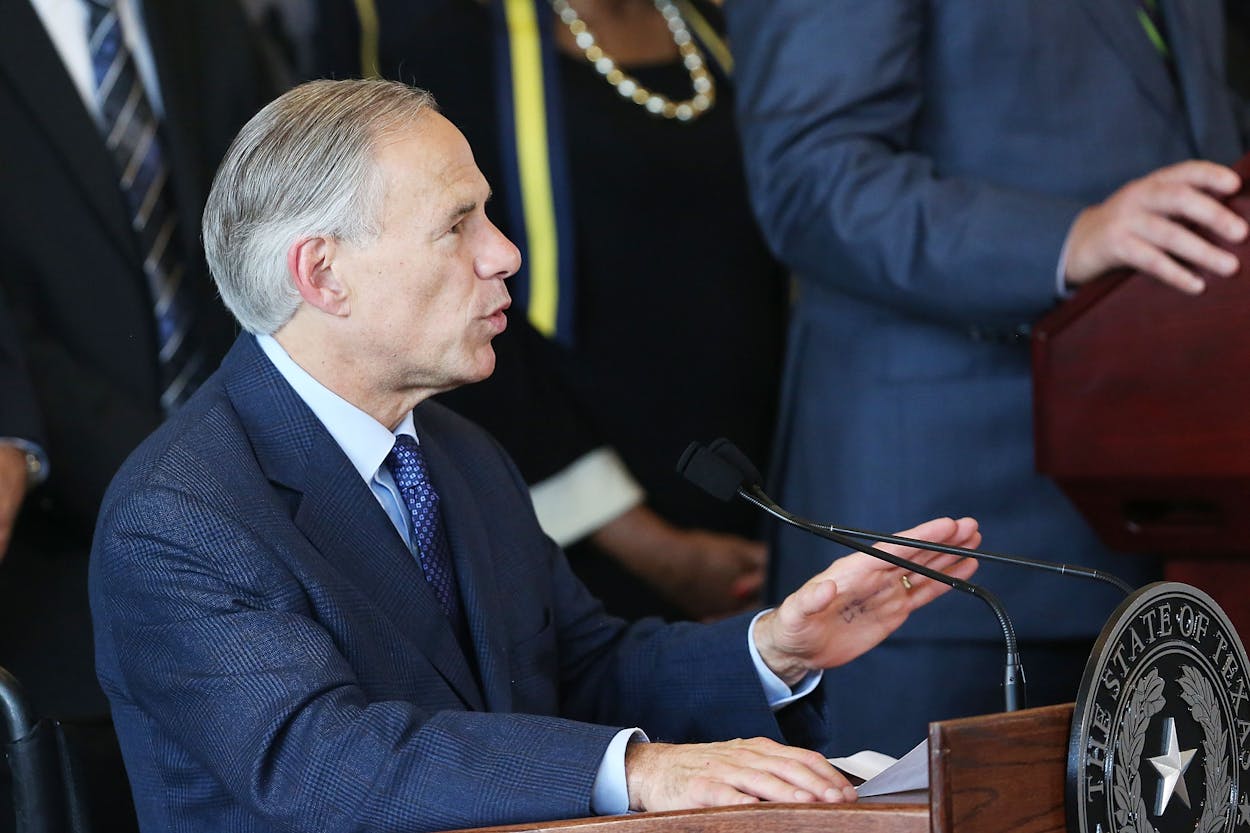In his state of the state address to the Legislature this week, Governor Greg Abbott said some law enforcement officials were refusing to “enforce existing law.” “That is unacceptable,” he continued. “Elected officials don’t get to pick and choose which laws they obey.” That was almost certainly a thinly-veiled jab at Travis County Sheriff Sally Hernandez, who has recently faced of with the governor over sanctuary cities. On Wednesday, Abbott cancelled about $1.5 million in criminal justice grants to Travis County because of what he describes as Hernandez’s sanctuary city policy, which limits the release of undocumented inmates to Immigration and Customs Enforcement, or ICE, only in cases of murder, aggravated sexual assault, or human smuggling.
The ultimate rub, however, is that the Immigration and Customs Enforcement detainers given to local sheriffs are completely voluntary in compliance. Why? If the detainers were mandatory, they would violate Tenth Amendment separation of powers between the federal government and the states. In short, a system that should be simple and straight forward is a confusing mess.
The Texas Senate State Affairs Committee is taking up Senate Bill 4 on Thursday, which would force local law enforcement into greater cooperation with the federal immigration officials by withholding state dollars if they don’t. The flip side is that sheriffs who comply may face lawsuits under the Fourth Amendment for the warrantless detention of an individual. And all of this is happening just after President Donald Trump issued an executive order undoing the ICE policies of former President Obama last week.
Under Obama’s Priority Enforcement Program that existed two weeks ago, ICE only targeted “individuals convicted of significant criminal offenses or who otherwise pose a threat to public safety” and “will only seek transfer of individuals in state and local custody in specific, limited circumstances.” That policy also only applied to persons accused of most misdemeanors once they were convicted. Trump’s order wiped that out and replaced it with the Secure Communities program that existed before 2012. Under this policy, ICE can place request holds on individuals in jail even when they are “not yet convicted.”
Trump declared that any local government that did not comply could face having its federal funds withheld. San Francisco, which actually has designated itself as a sanctuary city, filed a federal lawsuit claiming it stood to lose $1.2 billion a year in federal aid, and that Trump’s order violated the Tenth Amendment by trying to use state officials to enforce federal law.
A federal judge in Chicago last fall ruled that the detainers exceeded ICE’s authority for warrantless arrests under federal immigration laws. At present, the ruling only affects the Northern District of Illinois, but attorney Mark Fleming of the National Immigrant Justice Center said the premise may soon affect other jurisdictions, such as Texas. If the courts rule the detainers are an unconstitutional warrantless arrest, the federal government might lose its ability to use federal grant money as a carrot for local governments to comply with immigration laws. “It may be difficult to withhold money for something that is unconstitutional,” Fleming said.
In fact, the ICE detainer form notes explicitly that compliance by the local law enforcement office is a request and not an order. And it tells the detained person that if they that if they have not been picked up by an ICE agent in that time they should “ inquire about your release from state or local custody.”
In practice, the ICE detainers do not apply to the most serious criminals, because the state is not going to hand them over for deportation until they have served time for their crimes. Texas prisons, as of December 31, housed 8,923 inmates with ICE detainers on them, with 6,688 positively identified as undocumented immigrants, according to Jason Clark, director of public information for the Texas Department of Criminal Justice. Some studies also have found indications that undocumented immigrants are less likely to commit serious crimes than people who are native-born citizens. The American Immigration Council found in 2010 Census data that only 1.6 percent of the immigrant males between the ages of 18-29 were incarcerated, while 3.9 percent of the native-born population in that age group were incarcerated. An anecdotal review of the ICE detainers at the Travis County sheriff’s website indicates most of the inmates are being held on crimes such as driving while intoxicated or domestic violence.
However, Abbott launched into the Dallas sheriff in October when she announced the county would no longer automatically honor the 48-hour hold on immigrant charged with minor offenses but would review them on a “case by case” basis. “Your refusal to fully participate in a federal law enforcement program intended to keep dangerous criminals off the streets leaves the state no choice but to take whatever actions are necessary to protect our fellow Texans,” Abbott said in a letter to Valdez.
Valdez spokesperson Melinda Urbina told me that the policy was in keeping with the ICE enforcement that was in effect at the time. “It was taken out of context and misunderstood” by the governor, Urbina said. She said the governor overlooked the fact the sheriff had complied with 1,778 detainers in 2015 and 2,527 in 2016. Urbina said the sheriff is trying to determine exactly how to handle the detainers under Trump. “We’re in a big state of hypothetical right now,” she said.
But the county also is facing a lawsuit from immigrants who claim the detainers were abused by Dallas as an excuse to keep them jailed while awaiting trial, rather than freeing them on bond. “There were some guys who were there for weeks, months,” said Anthony Garza, a lawyer representing the offenders.
When I asked Garza if Dallas was a sanctuary city, he replied, “I would have a hard time saying yes.”






